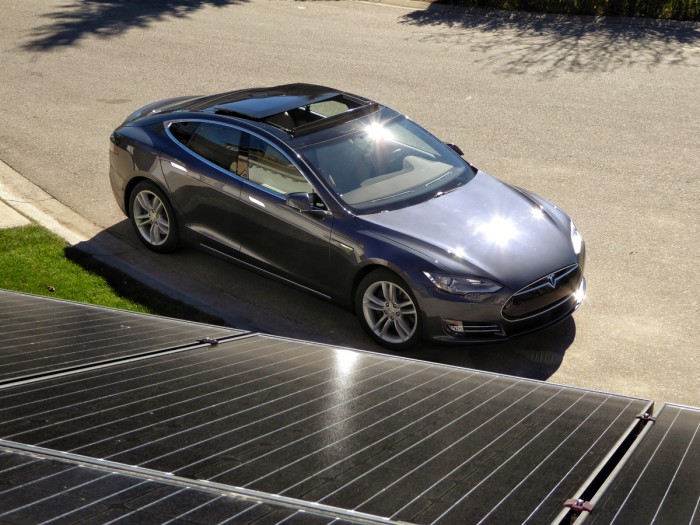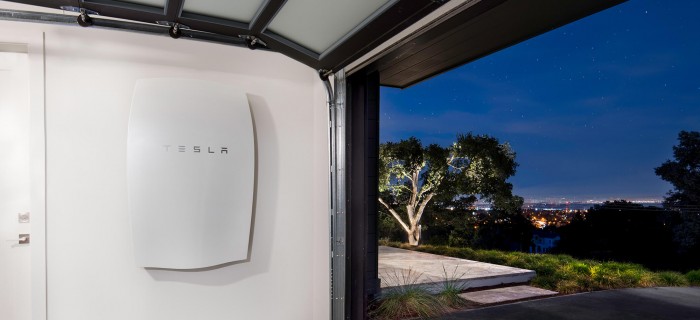Tesla-SolarCity Success Depends on Battery Technology That Doesn’t Yet Exist
Vowing to create “the world’s only vertically integrated energy company offering end-to-end clean energy products to our customers,” Tesla CEO Elon Musk said on Tuesday that the electric-vehicle maker plans to acquire SolarCity, the largest U.S. installer of rooftop solar arrays. Musk is also the chairman and cofounder of SolarCity, and his cousin Lyndon Rive is the company’s CEO.
There are plenty of business and financial reasons to be skeptical of this deal: for one thing, the two companies lost a combined $1.7 billion last year, losses that are only growing. Many observers believe that Musk’s plan is based more on a desire to shore up SolarCity’s faltering business than any benefits to shareholders or customers. The solar provider has been hit hard by turmoil in the market for residential solar power, and its shares lost 64 percent of their value in the 11 months before the deal was announced.

But the real cause for concern may lie in Tesla’s technology. Musk’s vision of an end-to-end clean energy system, from the rooftop to the roadway as it were, will no doubt appeal to affluent consumers who can afford both sleek battery-powered cars and rooftop solar panels. That vision depends, though, on the strength of its electric vehicles, solar power, and home battery storage systems. And the last leg of that stool may be the weakest for the future of Tesla and SolarCity.
Tesla unveiled its Powerwall system just over a year ago with great fanfare: saying that Powerwall-equipped homes would become “microgrids.” Musk noted that homeowners will be able to both supply their own needs by capturing solar energy during the day and storing it for use at night, and to sell power back onto the grid. Musk said the seven-kilowatt-hour Powerwall would cost $3,000, less than comparable systems. But the full cost, including installation, can reach close to $10,000, according to many estimates.

What’s more, the price of energy from SolarCity panels plus the Powerwall, in terms of cents per kilowatt-hour, is 25 to 30 cents per kilowatt-hour or more, according to multiple analyses (those figures account for the energy price factored into a typical SolarCity lease, plus the upfront cost of the Powerwall over the lifetime of the system—see this analysis for more). That is much higher than the average cost of electricity in the United States, which is around 12.5 cents per kilowatt-hour, according to the U.S. Energy Information Administration. It’s not clear what the advantage, in terms of price, of storing solar power for nighttime use would be compared to simply using power from the grid at night.
Tesla is investing at least $4 billion to build a mammoth factory in the Nevada desert to make lithium-ion batteries for its cars and for the Powerwall and Powerpack systems. The advanced lithium-ion batteries produced at the "Gigafactory” will be more sophisticated, and less expensive, than the Panasonic batteries that have so far powered Tesla’s cars and energy storage systems (see “The Tesla Model 3 May Depend on This Battery Breakthrough”). Tesla says it expects to drive down the per-kilowatt-hour cost of its battery pack by more than 30 percent by 2017. But it will take years for the Nevada factory to reach full production, and in the meantime Tesla will continue to import Panasonic batteries. For now, the Powerwall uses what are essentially commodity batteries that offer little performance or price advantages over competitors’ products.
“At the end of the day, the Powerwall has the same li-ion battery cells in it as any other li-ion-based storage product: Asian-sourced batteries that are arranged in packs,” says Jay Whitacre, a professor of engineering and public policy at Carnegie Mellon University and the founder of Aquion Energy, which makes batteries for residential use. “It's basically off-the-shelf cell technology.”
Ultimately, Musk’s vision of a world of electric vehicles powered by solar energy captured on rooftops and stored in home batteries may become reality. For now, though, it’s a tiny market of enthusiasts and clean-energy early adopters.
“Until solar and storage becomes a commercial proposition, driven by long-term utility tariff structures, there isn’t really much of a market,” says Jim McDowall, director of business development at Saft, a maker of lithium-ion batteries for industrial applications. “Adding EVs to the picture is a feel-good proposition at best.”
Keep Reading
Most Popular
Large language models can do jaw-dropping things. But nobody knows exactly why.
And that's a problem. Figuring it out is one of the biggest scientific puzzles of our time and a crucial step towards controlling more powerful future models.
How scientists traced a mysterious covid case back to six toilets
When wastewater surveillance turns into a hunt for a single infected individual, the ethics get tricky.
The problem with plug-in hybrids? Their drivers.
Plug-in hybrids are often sold as a transition to EVs, but new data from Europe shows we’re still underestimating the emissions they produce.
Stay connected
Get the latest updates from
MIT Technology Review
Discover special offers, top stories, upcoming events, and more.